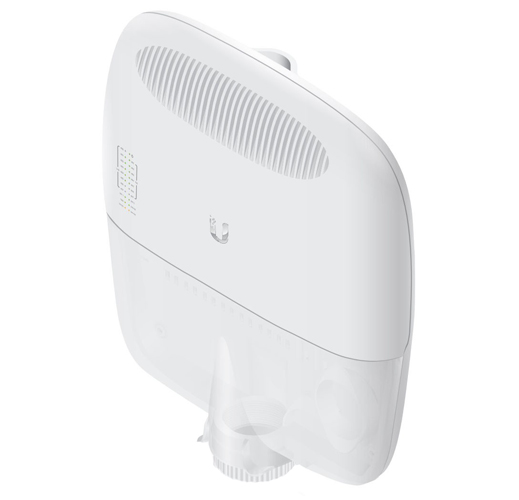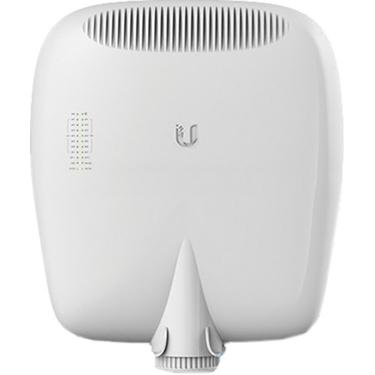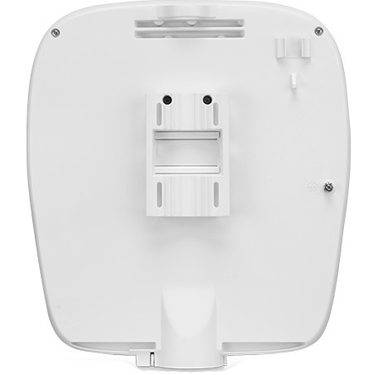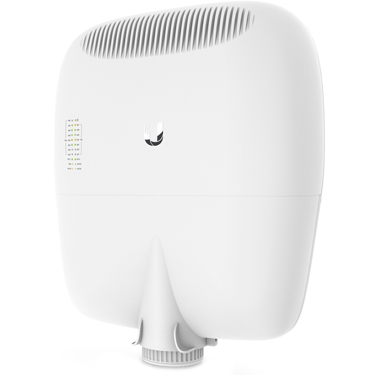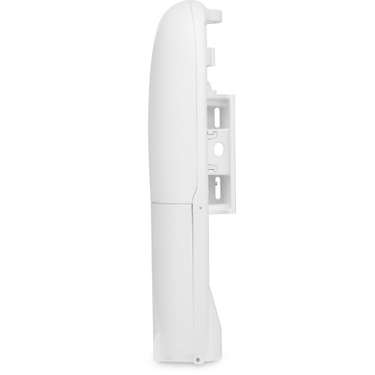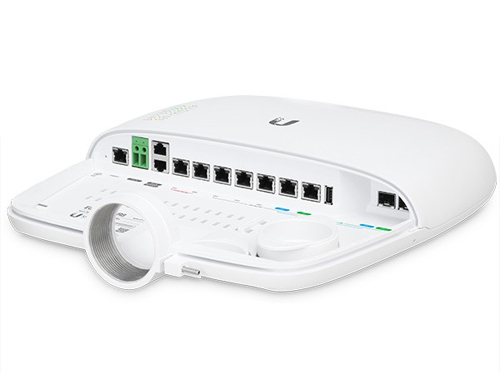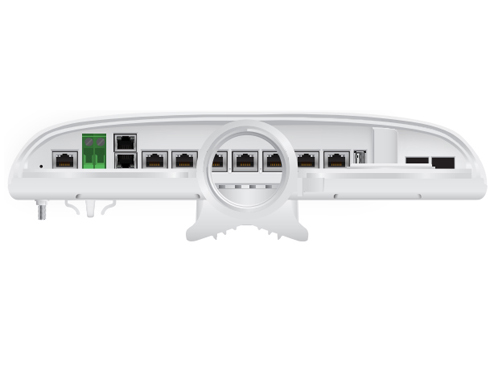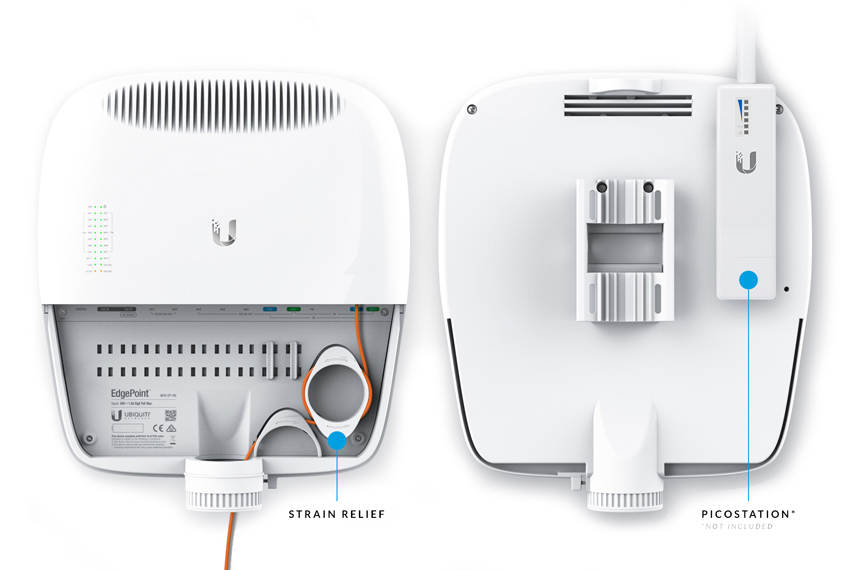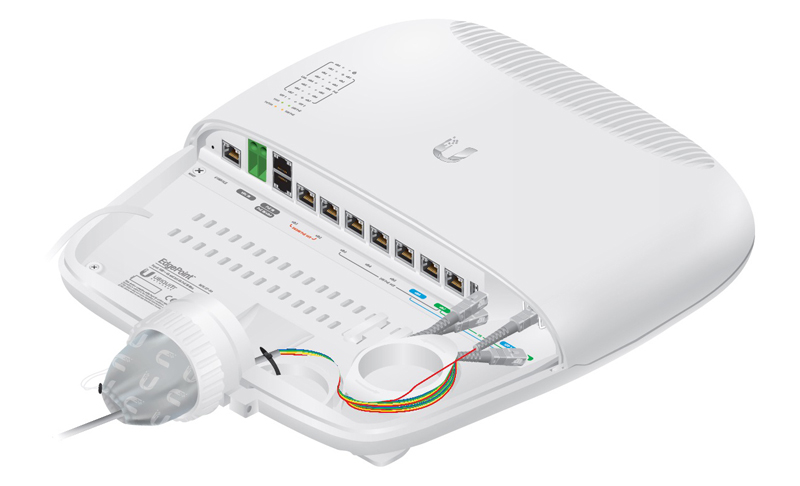Overview:
 Advanced Routing Technology for the Masses
Advanced Routing Technology for the Masses
Ubiquiti Networks introduces the EdgePoint, part of the EdgeMAX platform. The first application-specific designed WISP control point, the EdgePoint combines EdgeMAX routing features with fiber backhaul and versatile powering capabilities. The EdgePoint offers an innovative combination of robust routing performance, fiber backhaul capability, and the convenience of passive PoE support.

EdgePoint R8
Model: EP-R8
The EP-R8 features six RJ45 Ethernet ports and two combination RJ45/SFP Ethernet ports.
Bottom Panel
- Power Options
- 54VDC, 3A Terminal Block
- Dual PoE Input
- (1) Console Port
- Data Ports
- (6) RJ45 Ports
- (2) Combination RJ45/SFP Ports
- Nine RJ45 ports support PoE:
- PoE Input
- (1) 54V, 1.5A (No Data)
- (1) 54V, 1.5A
- PoE Output
- (2) 54 or 24V, 1.4A Passive PoE Output Ports*
- (5) 24V, 0.7A Passive PoE Output Ports*
Cabling Protection
- Strain Relief for Fiber Optic Strands
- Cable Sleeve and Option for Conduit (Not Included)
- Cable Tie Slots (Cable Ties Not Included)
Back Panel
- Lanyard Loop for Ease of Installation
- Slot for PicoStation®M2HP (Not Included) to Allow for Wireless Management
- Pole-Mount Bracket (Wall-Mount Bracket Also Included)
- Ground Bonding Point
Robust Construction
The ruggedized case withstands outdoor conditions, including wind, rain, and snow. The included cable sleeve protects the cables and cable opening. If you prefer, you can swap it out for your own conduit.
Advanced Applications
For the EP-R6 and EP-R8, powerful routing features – such as load balancing and failover– provide redundancy and increased performance for outdoor wireless links.
Versatile Power Options
Powered by 54VDC or by PoE, the EP-R8 and EP-S16 can support 54 or 24V passive PoE to power all Ubiquiti products, including airFiber and airMAX.
Features:
Breakthrough in Tower Deployment
The EdgePoint features FiberProtect to significantly reduce electrostatic discharge (ESD) failures and electromagnetic interference (EMI), greatly improve data signal integrity, and consolidate the wired data backhaul to a single fiber cable run for long-distance connectivity.
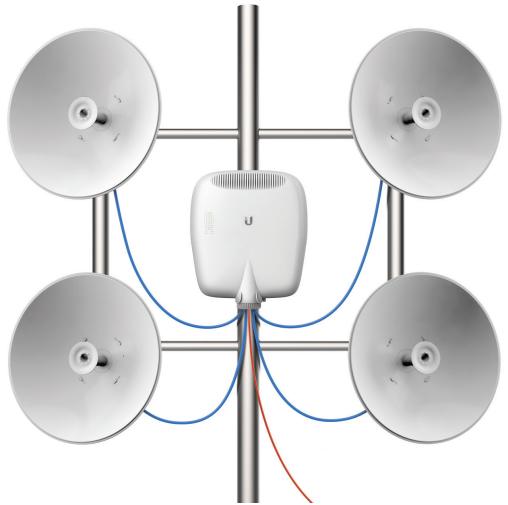
Example of a Backhaul Deployment for the EdgePoint
The EdgePoint runs fiber to the top of the tower so no cabinet is needed and there are no long Ethernet cable runs.
All-in-One Design
A single, compact controller eliminates clutter, expensive cabinets, extraneous installations, and excessive maintenance.
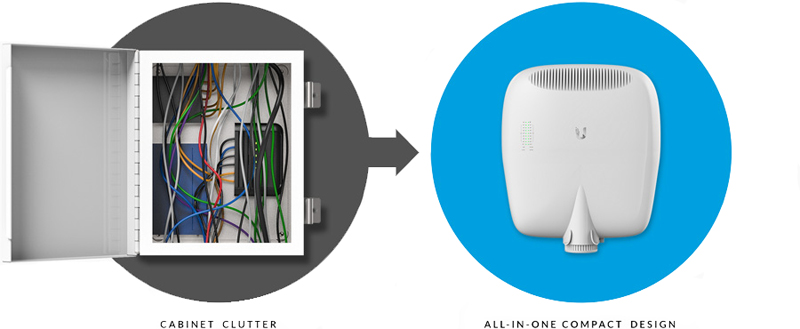
Example of EdgePoint as WISP Control Point
The EdgePoint replaces a cabinet containing a patch panel, power rack, multiple PoE adapters, syslog server, AP (for EdgePoint management), switch, router, and modem.
Advanced Routing Applications
Powerful routing features – such as link balancing – provide redundancy and increased performance for outdoor wireless links.
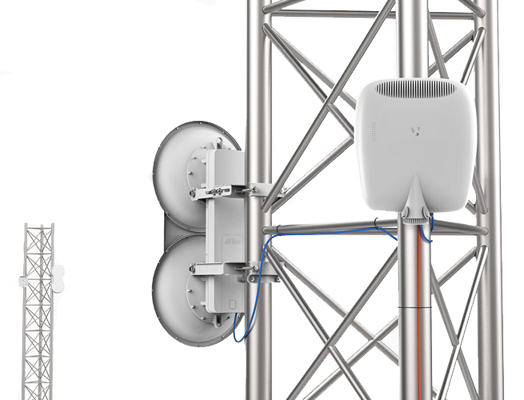
Specifications:
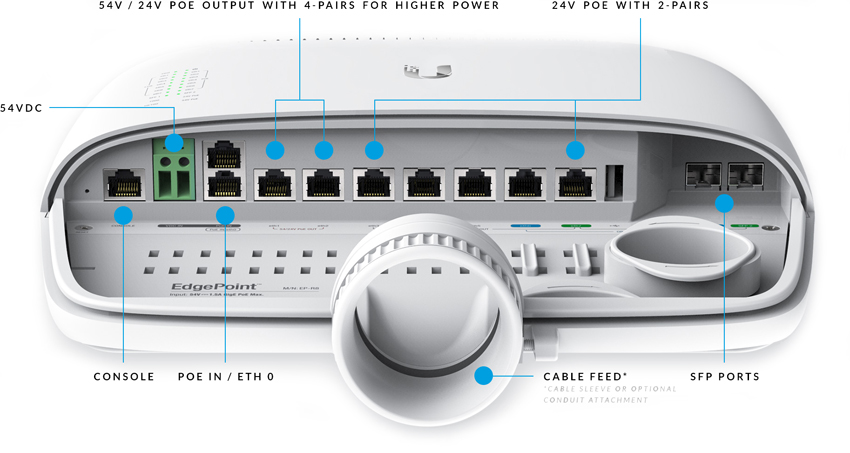
Bottom Panel View
| EdgePoint R8 Specification |
| Dimensions |
326.6 x 382.7 x 88.8 mm (12.86 x 15.07 x 3.50")
With Wall-Mount: 326.6 x 382.7 x 105.5 mm (12.86 x 15.07 x 4.15") |
| Weight |
3.4 kg (7.50 lb)
With Wall-Mount: 3.8 kg (8.38 lb) |
| Enclosure Characteristics |
Diecast Aluminum Alloy and Polycarbonate with UV Resistance |
| Max. Power Consumption |
40W (Excludes PoE Output) |
| Power Input |
(1) DC Terminal Block or (2) RJ45 (PoE In and eth0)
(Self-Correcting Polarity Protection on DC Terminal Block Only, Diode ORed Protection on All Power Inputs) |
| Power Supply |
Min. 54V / 0.8A (Excludes PoE Output Power) |
| VDC Input |
54VDC, 6A |
| Passive PoE Input |
(2) 54V / 1.5A, 4-Pair (+1, 2, 4, 5; -3, 6, 7, 8) Passive PoE, eth0 and PoE In
(PoE In is DC Only, No Data) |
| Passive PoE Output |
(2) 54V or 24V / 1.4A, 4-Pair (+1, 2, 4, 5; -3, 6, 7, 8) Passive PoE, eth1 to eth2
(5) 24V / 0.7A, 2-Pair (+4, 5; -7, 8) Passive PoE, eth3 to eth7 |
| Power Monitoring |
(1) DC Terminal Block, Input Power
(2) RJ45, PoE In and eth0, Input Power |
| Supported Voltage Range |
56 to 42VDC |
| Button |
Reset |
| LEDs |
System: Power
eth0: Speed/Link/Activity
eth1 to eth7: Speed/Link/Activity, PoE
SFP: Speed/Link/Activity |
| Ports |
Serial Console Port: (1) RJ45 Serial Port
PoE In Port: (1) RJ45 Port
Data Ports: (6) 10/100/1000 RJ45 Ports, (2) 10/100/1000 RJ45/SFP Combination Ports |
| Processor |
Dual-Core 600 MHz, MIPS64 with Hardware Acceleration for Packet Processing |
| System Memory |
2 GB DDR3-1600 RAM |
| Code Storage |
4 GB |
| Certifications |
CE, FCC, IC |
| Pole Mount |
Yes |
| Operating Temperature |
-40 to 65° C (-40 to 149° F) |
| Operating Humidity |
10 to 90% Noncondensing |
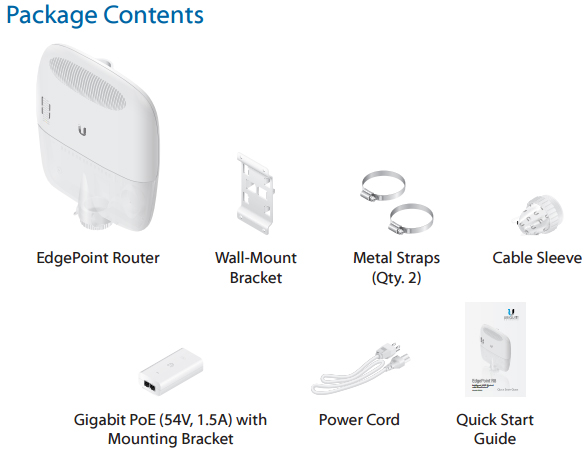
Software Specifications:
Software Information
Core Switching Features
- ANSI/TIA-1057: LLDP-Media Endpoint Discovery (MED)
- IEEE 802.1AB: Link Layer Discovery Protocol (LLDP)
- IEEE 802.1D: Spanning Tree Compatibility
- IEEE 802.1S: Multiple Spanning Tree Compatibility
- IEEE 802.1W: Rapid Spanning Tree Compatibility
- IEEE 802.1Q: Virtual LANs with Port-Based VLANs
- IEEE 802.1p: Ethernet Priority with User Provisioning and Mapping
- IEEE 802.1X: Port-Based Authentication with Guest VLAN Support
- IEEE 802.3: 10BASE-T
- IEEE 802.3u: 100BASE-T
- IEEE 802.3ab: 1000BASE-T
- IEEE 802.1ak: Virtual Bridged Local Area Networks - Amendment 07: Multiple Registration Protocol
- IEEE 802.3ac: VLAN Tagging
- IEEE 802.3ad: Link Aggregation
- IEEE 802.3x: Flow Control
- IEEE 802.1D-2004: Generic Attribute Registration Protocol: Clause 12 (GARP)
- IEEE 802.1D-2004: Dynamic L2 multicast registration: Clause 10 (GMRP)
- IEEE 802.1Q-2003: Dynamic VLAN registration: Clause 11.2 (GVRP)
- RFC 4541: Considerations for Internet Group Management Protocol (IGMP) Snooping Switches
- RFC 5171: Unidirectional Link Detection (UDLD) Protocol
Advanced Layer 2 Features
- Broadcast Storm Recovery
- Broadcast/Multicast/Unknown Unicast Storm Recovery
- DHCP Snooping
- IGMP Snooping Querier
- Independent VLAN Learning (IVL) Support
- Jumbo Ethernet Frame Support
- Port MAC Locking
- Port Mirroring
- Protected Ports
- Static MAC Filtering
- TACACS+
- Voice VLANs
- Unauthenticated VLAN
- Internal 802.1X Authentication Server
Platform Specifications
- DHCP Server
- Maximum Number of Pools: 128
- Maximum Number of Leases (Total): 2048
- Routing
- Number of Routes: 16
- Number of Routing Interfaces: 15
- VLANs: 255
- MAC Addresses: 8k
- MSTP Instances: 4
- LAGs: 6
- ACLs: 100 with 10 Rules per Port
- Traffic Classes (Queues): 8
Management
- Web UI
- Industry-Standard CLI
- IPv6 Management
- Password Management
- Autoinstall Support for Firmware Images and Configuration Files
- SNMP v1, v2, and v3
- SSH 1.5 and 2.0
- SSL 3.0 and TLS 1.0
- Secure Copy (SCP)
- Telnet (Multi-Session Support)
System Facilities
- Event and Error Logging Facility
- Run-Time and Configuration Download Capability
- PING Utility
- FTP/TFTP Transfers via IPv4/IPv6
- Malicious Code Detection
- BootP and DHCP
- RFC 2021: Remote Network Monitoring Management Information Base Version 2
- RFC 2030: Simple Network Time Protocol (SNTP)
- RFC 2819: Remote Network Monitoring Management Information Base
- RFC 2865: RADIUS Client
- RFC 2866: RADIUS Accounting
- RFC 2868: RADIUS Attributes for Tunnel Protocol Support
- RFC 2869: RADIUS Extensions
- RFC 3579: RADIUS Support for EAP
- RFC 3580: IEEE 802.1X RADIUS Usage Guidelines
- RFC 3164: BSD Syslog Protocol
Layer 3 Routing
- Static Routing
- Policy Based Routing
QoS
- Access Control Lists (ACLs), Permit/Deny Actions for Inbound IP and Layer 2 Traffic Classification Based on:
- Time-Based ACL
- Source/Destination IP Address
- TCP/UDP Source/Destination Port
- IP Protocol Type
- Type of Service (ToS) or Differentiated Services (DSCP) Field
- Source/Destination MAC Address
- EtherType
- IEEE 802.1p User Priority
- VLAN ID
- RFC 1858: Security Considerations for IP Fragment Filtering
- Optional ACL Rule Attributes
- Assign Flow to a Specific Class of Service (CoS) Queue
- Redirect Matching Traffic Flows
- Differentiated Services (DiffServ)
- Classify Traffic Based on Same Criteria as ACLs
- Mark the IP DSCP or Precedence Header Fields, Optional
- Police the Flow to a Specific Rate with Two-Color Aware Support
- RFC 2474: Definition of the Differentiated Services Field (DS field) in the IPv4 and IPv6 Headers
- RFC 2475: An Architecture for Differentiated Services
- RFC 2597: Assured Forwarding Per-Hop Behavior (PHB) Group
- RFC 3246: An Expedited Forwarding PHB
- RFC 3260: New Terminology and Clarifications for DiffServ
- Class of Service (CoS) Queue Mapping Configuration
- AutoVoIP: Automatic CoS Settings for VoIP
- IP DSCP-to-Queue Mapping
- Configurable Interface Trust Mode (IEEE 802.1p, DSCP, or Untrusted)
- Interface Egress Shaping Rate
- Strict Priority versus Weighted Scheduling per Queue
Software:
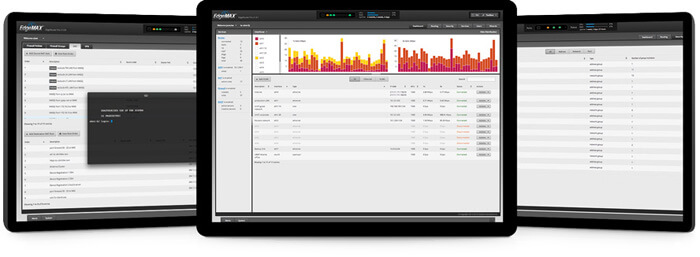

EdgeMAX Software Platform
EdgeOS provides an intuitive, easy-to-use graphical user interface that makes router features simple to configure and monitor. It even comes with an integrated command-line interface (CLI) right in the browser, allowing access to all the advanced functions of the router.
Intuitive User Interface
The EdgePoint features a graphical user interface designed for convenient setup and control. Accessed via a network port and web browser, the user-friendly interface provides intuitive management with a virtual view of the ports, displaying physical connectivity, speed, and status.
Depending on whether you are configuring a router (EP-R6 or EP-R8) or switch (EP-S16), the configuration interface will differ.
Routing Configuration
The EP-R6 or EP-R8 offers robust features, including:
- VLAN interfaces for network segmentation
- Static routes and support of routing protocols: OSPF, RIP, and BGP
- Firewall policies and NAT rules
- Application identification with Deep Packet Inspection (DPI)
- DHCP services
- Quality of Service (QoS)
- Network administration and monitoring tools
- Administrator and operator accounts
- Comprehensive IPv6 support
Switching Configuration
The EP-S16 provides advanced features, including:
- MSTP/RSTP/STP
- VLAN, Private VLAN, Voice VLAN
- Link Aggregation
- DHCP Snooping, IGMP Snooping
- TACACS+, RADIUS, 802.1X, MAC Filtering, ACL
- DiffServ, CoS
- Static Routing, Policy-Based Routing
Configuration by CLI
The CLI provides quick and flexible configuration by command line and features the following:
- For power users, configuration and monitoring of all advanced features
- Direct access to standard Linux tools and shell commands (EP-R6 or EP-R8 only)
- CLI access through the following:
- Serial console port (EP-R8 or EP-S16 only)
- SSH
- Telnet
- Graphical user interface (EP-R6 or EP-R8 only)
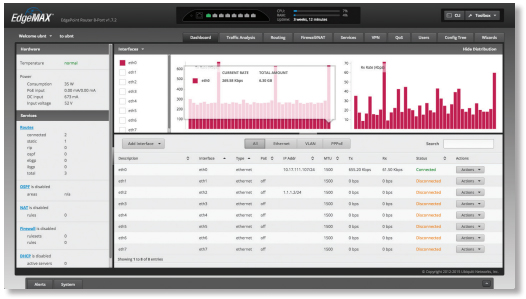
For the EP-R8, the Dashboard screen displays detailed statistics: IP information, MTU, transmit and receive speeds, and status for each interface.
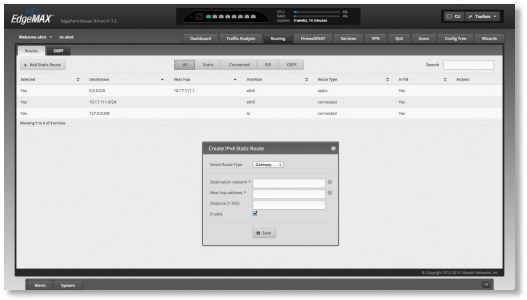
For the EP-R8, the Routing > Routes screen displays static, connected, RIP, and/or OSFP routes. You can add static routes on this screen.
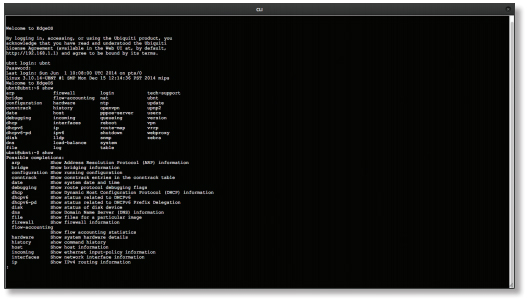
An industry-standard command-line interface (CLI) is available for advanced users.
| EdgeOS Specifications |
| Interface/Encapsulation |
Ethernet
802.1q VLAN
PPPoE
GRE
IP in IP
Bridging
Bonding (802.3ad) |
| Addressing |
Static IPv4/IPv6 Addressing
DHCP/DHCPv6 |
| Routing |
Static Routes
OSPF/OSPFv3
RIP/RIPng
BGP (with IPv6 Support)
IGMP Proxy |
| Security |
ACL-Based Firewall
Zone-Based Firewall
Application Identification with Deep Packet Inspection (DPI)
NAT |
| VPN |
IPSec Site-to-Site and Remote Access
OpenVPN Site-to-Site and Remote Access
PPTP Remote Access
L2TP Remote Access
PPTP Client |
| Services |
DHCP/DHCPv6 Server
DHCP/DHCPv6 Relay
Dynamic DNS
DNS Forwarding
VRRP
RADIUS Client
Web Caching
PPPoE Server |
| QoS |
FIFO
Stochastic Fairness Queueing
Random Early Detection
Token Bucket Filter
Deficit Round Robin
Hierarchical Token Bucket
Ingress Policing |
| Management |
Web UI
CLI (Console, SSH, Telnet)
SNMP
NetFlow
LLDP
NTP
UBNT Discovery Protocol
Logging |
Miscellaneous:
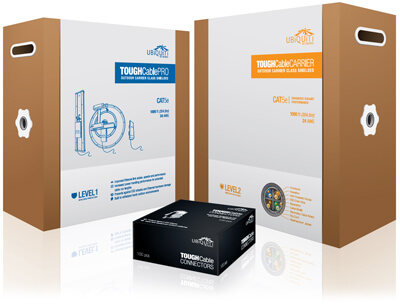

Protect your networks from the most brutal environments with Ubiquiti's industrialgrade shielded ethernet cable, TOUGHCable.
- Increase Performance - Dramatically improve your ethernet link states, speeds, and overall performance with Ubiquiti TOUGHCables.
- Extreme Weatherproof - TOUGHCables have been built to perform even in the harshest weather and environments.
- ESD Damage Protection - Protect your networks from devastating electrostatic discharge (ESD) attacks.
- Extended Cable Support - TOUGHCables have been developed to have increased power handling performance for extended cable run lengths.
Bulletproof your networks
TOUGHCable is currently available in two versions: PRO Shielding Protection and CARRIER Shielding Protection.
TOUGHCable PRO is a Category 5e, outdoor, carrier-class shielded cable with an integrated ESD drain wire.
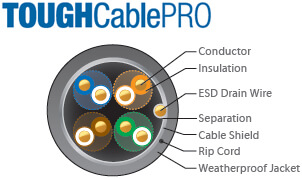
TOUGHCable CARRIER is a Category 6, outdoor, carrier-class shielded cable that features an integrated ESD drain wire, anti-crosstalk divider, and secondary shielding. It is rated to provide optimal performance on Gigabit Ethernet networks.
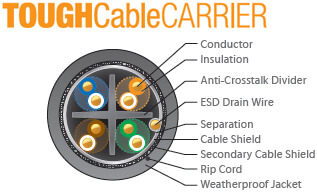
Additional Information:
- 24 AWG copper conductor pairs
- 26 AWG integrated ESD drain wire to prevent ESD attacks and damage
- PE outdoor-rated, weatherproof jacket
- Multi-layered shielding
- Available in lengths of 1000 ft (304.8 m)
TOUGHCable Connectors
Specifically designed for use with Ubiquiti TOUGHCables and available in 100 pc. bags, TOUGHCable Connectors protect against ESD attacks and Ethernet hardware damage while allowing rapid field deployment without soldering.
| ESD attacks are the leading cause for device failures. The diagram below illustrates the areas vulnerable to ESD attacks in a network. |
By using a grounded Ubiquiti Power over Ethernet (PoE) Adapter along with Ubiquiti TOUGHCable and TOUGHCable Connectors, you can effectively protect against ESD attacks. |
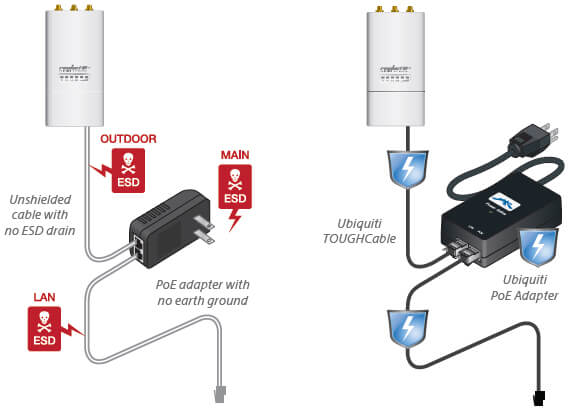 |

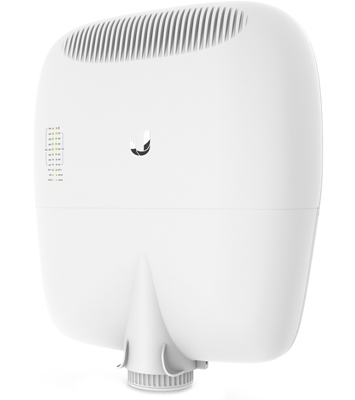
 Advanced Routing Technology for the Masses
Advanced Routing Technology for the Masses![]()




